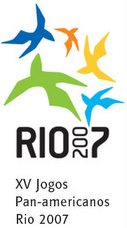The Pan American games are a continental version of the Olympic Games which includes the Olympic Program sports and others that are not part of the Olympics. Conducted every four years, always one year before the Olympic Games, the first Pan American Games were held in 1951, in Buenos Aires, capital of Argentina. However, its origin dates back to 1932, in the Los Angeles Olympic Games. Inspired by the holding of the first Central American Games six years earlier, the Latin American representatives of the International Olympic Committee (IOC) proposed the creation of a competition that would include all the countries in the Americas, for the purpose of strengthening sport activities in the region.
The idea resulted in the first Pan American Sports Congress, held in Buenos Aires in 1940. In principle the Congress determined that the inaugural games would be held in 1942 in the Argentine capital - plans that were postponed due to World War II.
At the end of the conflict, a second Pan American Sports Congress in London during the 1948 Olympic Games, confirmed Buenos Aires as the host for the first Pan American Games, finally scheduled for 1951.
Competitions started on February 25th and included 2,513 athletes from 21 countries, with 18 sports.
Over more than 50 years, the Pan American Games never failed to occur, and have been held in cities in every corner of the continent.
From the extreme north, like Winnipeg (Canada), host of two events - 1967 and 1999 - to the south, like Mar del Plata (Argentina) which hosted the 1995 Games. The Pan American Games also visited Mexico City (Mexico), Chicago (USA), Cali (Colombia), San Juan (Puerto Rico), Caracas (Venezuela), Indianapolis (USA), Havana (Cuba) and Santo Domingo (Dominican Republic).
In addition, the Games have already been to Brazil. In 1963, São Paulo was the host to the fourth edition of the event. The Games were a success, mobilizing the entire city to the point where 40 thousand people attended the Opening Ceremony held at the Pacaembu Stadium.
The Pan American Games have been growing in size and importance with as edition of the event occurs. In less than half a century, the event has doubled in number of countries, athletes, and sports, becoming one of the main events in the world's sports calendar.
The editions of the Pan American Games are as follows:
1951 - Buenos Aires (Argentina) - February 25th to March 9th
2,513 athletes, 21 countries, 18 sports
1955 - Mexico City (Mexico) - March 12th to 26th
2,583 athletes, 22 countries, 17 sports
1959 - Chicago (USA) - August 27th to September 7th
2,263 athletes, 25 countries, 18 sports
1963 - São Paulo (Brazil) - April 20th to May 5th
1,665 athletes, 22 countries, 19 sports
1967 - Winnipeg (Canada) - 24th July to August 6th
2,361 athletes, 29 countries, 18 sports
1971 - Cali (Colombia) - July 25th to August 8th
2,935 athletes, 32 countries, 18 sports
1975 - Mexico City (Mexico) - October 12th to 25th
3,146 athletes, 33 countries, 18 sports
1979 - San Juan (Puerto Rico) - July 1st to 15th
3,700 athletes, 34 countries, 22 sports
1983 - Caracas (Venezuela) - August 14th to 29th
3,426 athletes, 36 countries, 23 sports
1987 - Indianapolis (USA) - August 7th to 23rd
4,453 athletes, 38 countries, 27 sports
1991 - Havana (Cuba) - August 8th to 18th
4,519 athletes, 39 countries, 26 sports
1995 - Mar del Plata (Argentina) - March 11th to 26th
5,144 athletes, 42 countries, 34 sports
1999 - Winnipeg (Canada) - July 23rd to August 8th
5,000 athletes, 42 countries, 34 sports
2003 - Santo Domingo (Dominican Republic) - August 1st to August 17th
5,500 athletes, 42 countries, 35 sports
2007 - Rio de Janeiro (Brazil) - July 13th to 29th
5,500 athletes*, 42 countries, 33 sports*
Assinar:
Postar comentários (Atom)

Nenhum comentário:
Postar um comentário